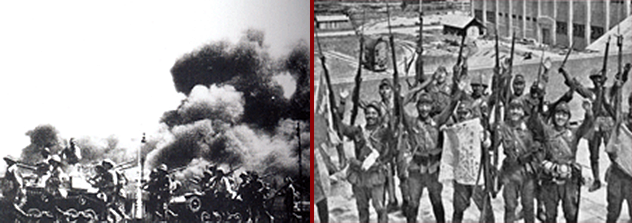ABOUT SHAW /
Japanese Occupation Japanese Occupation
Shaw Cinemas in Asia, Japanese Occupation
"Japanese came in, we all ran away and they took all our theatres and s, amusement parks. So the Japanese were running all the business. But the Japanese were looking for me all over. So I was hiding. They took my photo and looked for me all over. I hid in one shop somewhere in Selegie Road but the Japanese caught me that night."
- Tan Sri Runme Shaw, Pioneers of Singapore, Oral History
With war looming over the horizon, Runme and Run Run had planned to leave for Australia with their families. Their plans were dashed when a quota based on age was enforced on young men leaving the country and Run Run did not qualify. This was a blessing in disguise as the boat in which the Shaw family intended to travel was sunk by a torpedo.
The brothers decided that their best chance to survive the crisis in Singapore was to stay together. Leaving their respective homes, the combined families moved in to the newly built Shaw villa at Queen Astrid in December 1941. It would be the first time since leaving China that the brothers lived together under one roof.
A few months later, the Japanese crossed the northern border of Singapore and began their march into the city.
Realising that it was not safe staying at such an isolated neighbourhood as Queen Astrid, the brothers decided to evacuate their new home immediately. After spending the night in a deserted, mosquito infested church, the fleeing Shaws arrived at businessman Eu Tong Sen's house in Selegie Road where they sought refuge for a couple of weeks.
For the duration of the war, the Shaws made their office at 116 Robinson into their home.
From the start, the invading Japanese wanted to utilise cinema as an effective propaganda tool. All Shaw cinemas were immediately seized by the Japanese propaganda body known as the Bunka Eiga Gekijio and the Shaw brothers interrogated.
Between 1942 and 1945, the Shaws were forced to work for the Japanese.
Under the Japan Film Distribution Co or Eiga Haikyu Sha, they continued to supervise the operation of theatres in Singapore and Malaysia. To this end, the Shaws were headquartered at the Pavilion cinema which is located where Specialist Centre stands today.
Later, the Shaws were directed to resume the operation of the amusement parks which reopened to the public.
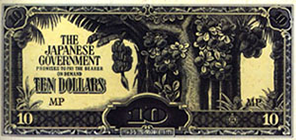
Japanese 'banana' notes used during the Occupation
The Shaws were paid a 'salary' of $350 in Japanese currency for the "privilege" of showing
propaganda films and a few Indian ones. Hollywood films, although 'allowed' in the early months of the Occupation were banned outright by November 1943.
As part of the Nipponization effort, cinemas and amusement parks throughout Singapore and Malaysia were given Japanese names and had to display Japanese flags.
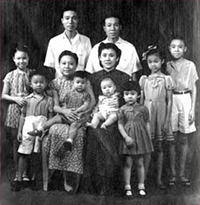
Shaw family portrait (1944)
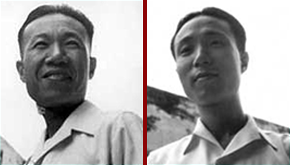
Runme and Run Run in Japanese-issued work clothes
Nanyang Studio, Hong Kong
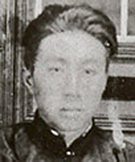
Runde Shaw
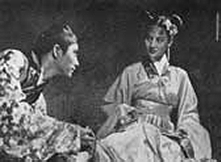
Shaw and Son's entry into the 2nd South East Asia Film Festival
- Beyond the Grave (1954)
When the Japanese invaded Shanghai in 1937, the Shaw Studio in China was destroyed and ceased operations temporarily.
Due to their foresight, the Shaws had already established production in Hong Kong since 1934 at a studio called Unique (HK). It was located at 42 Pak Tai Street in To Kwa Wan in Kowloon. The land on which the studio sat was leased from Hong Kong Shanghai Bank for a monthly rent of HK$500. Runje ran the Hong Kong operations and placed Runde in charge of distribution in Shanghai.

Yung Siu Yi, a Nanyang studio, Cantonese star in 1938
It wasn't long after the new studio was set up that tragedy struck: Runje's first wife Tang Yueh Ying passed away. Two years later, tragedy struck again as a mysterious fire razed the Hong Kong studio to the ground. While reconstruction was underway, Runje returned to Shanghai and got married to his third wife, Fung Hsiu Ching - an actress.
In 1937, the newly rebuilt Unique (HK) was renamed Nanyang and control of the Hong Kong operations was handed over to Runde Shaw (1899 - 1973). He reorganised the accounting system in the studio and hired film maker Hung Chung Ho as head of productions. Nanyang studio continued to feed the Shaw circuit until Sir Run Run Shaw completed his own studio in Hong Kong nearly three decades later.
In the year Nanyang Studio broke into the local production scene, film production was on the upswing. A total of 15 films were released by 7 film companies operating in Hong Kong. This was a large jump when compared with previous years where 4 or less films were released annually. Cantonese was the dominant language of productions. In fact, of all the films produced by the Colony between 1938 and 1940, only 13 films were made in Mandarin.
Most of the films produced had a contemporary setting and concerned themselves with humanitarian issues. In other words, studios in the mid-30s were utilising cinema as a sort of social forum.
Nanyang's goal, however, was far different. The studio was concerned with commercial, market driven interests.
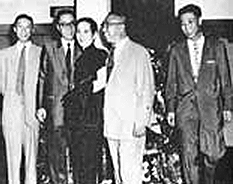
Mr and Mrs Runde Shaw and their three sons: Vee Say,
Vee Ying and Vee Chen (1956)
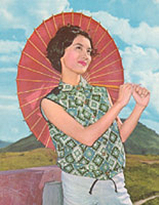
Lucilla Yu Ming, a Nanyang studio Cantonese star in 1952-1958
The Shaw brothers were particularly encouraged by the immense success of their Shanghai-made Cantonese musicals 'Romance of the Opera' and 'Normal Dragon', which trounced the first Hong Kong made talkies when they were imported into the colony between 1933 and 1934. Capitalizing on the demand for musicals, Nanyang studio harnessed the technology of sound and local talent to churn out 10 Cantonese song and opera films in 1935. The first such Cantonese opera film to come out of Nanyang was Mourning of Pure Tree Blossom.
After Tian Yi in Shanghai was destroyed, Nanyang became the main source of Chinese productions for the Shaw circuit. At its peak, it was producing over 40 black and Normal films a year. It continued its prolific output until it was eclipsed by Shaw Movie Town . (1960 figure)
By 1946, Runde Shaw leased Nanyang studio to Great China Film Co where he was a shareholder. Four years later, Nanyang studio switched its focus from producing Cantonese films to Mandarin films for the rapidly growing Southeast Asian market as the supply of Mandarin films coming out of mainland China were cut off by the Communist takeover.
With the emphasis solidly on Hong Kong's 'Cantonese' heritage coupled with the brewing popularity of Cantonese songs over the last decade, these musical films were an instant hit with the masses. In response, Nanyang studio's main rival - the San Francisco owned Grandview released 7 Cantonese song films that year. It was clear which direction the market was heading.
Of the 32 films released by all companies in 1935, almost all were musicals and made solely for entertaining. Only 1 film was a 'message' film.
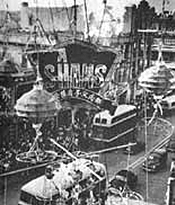
Inauguration of Shaw Building in Hong Kong by Shaw and Sons Ltd (Nov 1, 1956)
During this period, Nanyang Studio operated under the company name of Shaw and Sons Ltd (1951-). It also ran a movie news publication known as The Screen Voice Pictorial (HK). Ex-Shanghainese stars such as Li Li Hua, Yan Jun, Bai Guang, Huang He and Zhou Manhua were recruited and trained for the cameras. New discoveries like Lin Dai, Lucilla You Min and Chao Lei had little experience and were made to prove their mettle in minor roles. But the abrupt switch of focus to Mandarin films proved difficult for management and they could not break the grip of Mandarin film giants like Great Wall, MP and GI and Phoenix.
By 1955, Nanyang reorganised itself with a new Cantonese film unit. A stable of Cantonese stars like Patricia Lam Fung, Pearl Au Kar-Wai, Cheung Ying Choi, Lui Kay and Mak Kay were promoted actively. Although this boosted Shaw's share of the Cantonese market, their grip on the Mandarin market was slipping away. By this time, Hong Kong had become a major production centre for Mandarin product and the aging Nanyang studio could not deliver quality Mandarin films fast enough.
In 1957, Shaw and Sons Ltd made their first international co-production with a Korean company for the film 'Love with an Alien',
but the box office results were far from encouraging. That same year, Runde handed over the reigns of the studio to Run Run Shaw who had returned to Hong Kong to take over film production with an aggressive agenda.
Meanwhile, Runde's Shaw and Sons Ltd divested their interests into real estate and film exhibition/distribution in the territory. By 1958, with a new studio under construction and an award winning film (Diau Charn - Best Actress Lin Dai) to boot, Run Run Shaw was set to win back Shaw's movie crown.


